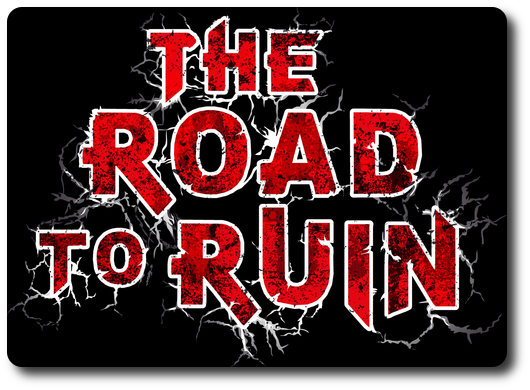
The Basics:
- For ages 8 and up (publisher suggests 13+)
- For 1 to 4 players
- Approximately 30 minutes to complete
Geek Skills:
- Active Listening & Communication
- Counting & Math
- Logical & Critical Decision Making
- Reading
- Strategy & Tactics
- Risk vs. Reward
- Cooperative & Team Play
- Hand/Resource Management
- Trading
Learning Curve:
- Child – Easy
- Adult – Easy
Theme & Narrative:
- In the land of the dead, it’s no fun being the living
Endorsements:
- Gamer Geek mixed!
- Parent Geek mixed!
- Child Geek mixed!
Overview
Whatever caused the dead to rise and hunt the living swept over the world like a prairie fire. In less than a week, whole cities were abandoned except by those who could not leave or were already part of the undead. What remains of the living hides in holes and is barely surviving. The alternative is not pleasant.
The Road to Ruin, designed by Justin Halliday and published by Hero Forge Games, is comprised of 25 Location cards, 18 Weapon cards, 25 Threat cards, 18 Item cards, 5 Survivor cards, 4 Wound cards, 4 Survivor tokens (in 4 different colors), 2 Marker cards, and 2 standard six-sided dice. The cards are as durable as your standard playing card and the artwork by Eric Quigley does a great job of depicting the broken world now inhabited by a handful of survivors and millions of undead.
The Dawn of the Dead
The set up the game, first decide which scenario will be used. The game comes with several that inform the players what special set up steps they need to take, the cards they need to use, and how the game is won or lost. We’ll cover the set up for the default and recommended first scenario titled “Supply Run”. Players can also create their own scenarios fairly easily.
Second, separate the “Safe House” Location card from the rest of the Location cards. Place the “Safe House” off-center in the middle of the playing area and shuffle the rest of the Location cards. Deal 5 Location cards face-down in a row below the “Safe House”. Above that, deal 3 Location cards face-down, then place the “Safe House” card face-up, and then deal 1 Location card face-down to create another row of 5 card. Above the second row, deal 3 more rows of face-down Location cards. These cards represent the area in which the players will be traveling, running, hiding, fighting, and getting eaten.
Third, place the 2 Marker cards off to one side of the game playing area. These marker cards help identify what each deck is used for and its discard pile. Place the Wound cards on its designated space on the Marker card and the dice next to it at this time.
Fourth, Search through the Item cards and remove the 6 “Supply” Item cards. Then shuffle the Threat cards and deal 18 face-down. Place the 6 “Supply” Item cards on top of the 18 Threat cards and shuffle. Deal 1 card, face-down, to each Location card except to the “Safe House” Location card. The remaining Item cards should be shuffled and placed face-down on its spot on the Marker card.
Fifth, shuffle the remaining Threat cards and place them face-down on their spot on the Marker card. Then do the Same with the Weapon cards to make the Weapon draw deck, which is placed on its spot face-down on the Marker card.
Sixth, each player selects a Survivor card or is dealt 1 randomly. The player places their Survivor card in front of them. Each player also selects 1 Survivor token and places it on the “Safe House” Location cards. Any Survivor cards and tokens not used are returned to the game box.
Seventh, each player draws up to 2 cards, either from the Weapon or the Item deck. Then 2 Item cards and 2 Weapon cards are drawn, revealed, and split among the players as they see fit. This represents the players’ starting equipment.
That’s it for game set up. Time to see where this road takes us.
A Bleak Landscape
The Road to Ruin is a game driven by cards. Some cards are known to the players right from the start and others are a mystery until they are turned over. The landscape is bleak with collapsed buildings, broken windows, streets littered with debris, and of course zombies. A summary of each of the cards used in the game follows.
The Survivors
The Survivor cards represent the unlucky few who get to live in a world that has gone to Hell. They are strong-willed, resourceful, and have long since given up any hope of rescue. They live to survive and have adapted to the horror show that is their lives. Equipment of any kind is a useful tool, but each Survivor has a special skill of their own that makes them unique. These include, but are not limited to, a favorite weapon, an advantage in certain fighting styles, and special movement. Each Survivor can take up to 3 wounds, with some being able to take more thanks to being stronger, tougher, or wearing armor.
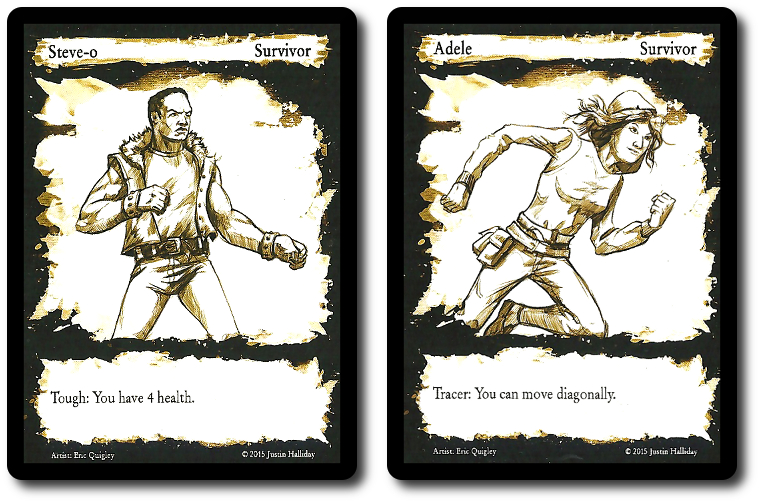
All Survivors can equip (have at the ready) 1 Weapon card and 1 “Gear” Item card. Everything else goes in the player’s hand which represents the Survivor’s inventory. A player can have a maximum of 4 cards in their hand by default.
Locations
There are three types of Location cards in the game. These are your general locations, hazard locations, and landmark locations. “Landmark” Location cards tend to be specifically mentioned by other scenarios and Location cards. “Hazard” Locations are dangerous to Survivors and will cause wounds simply by visiting or leaving them. The other Location cards represent general areas around the town and its surrounding area.
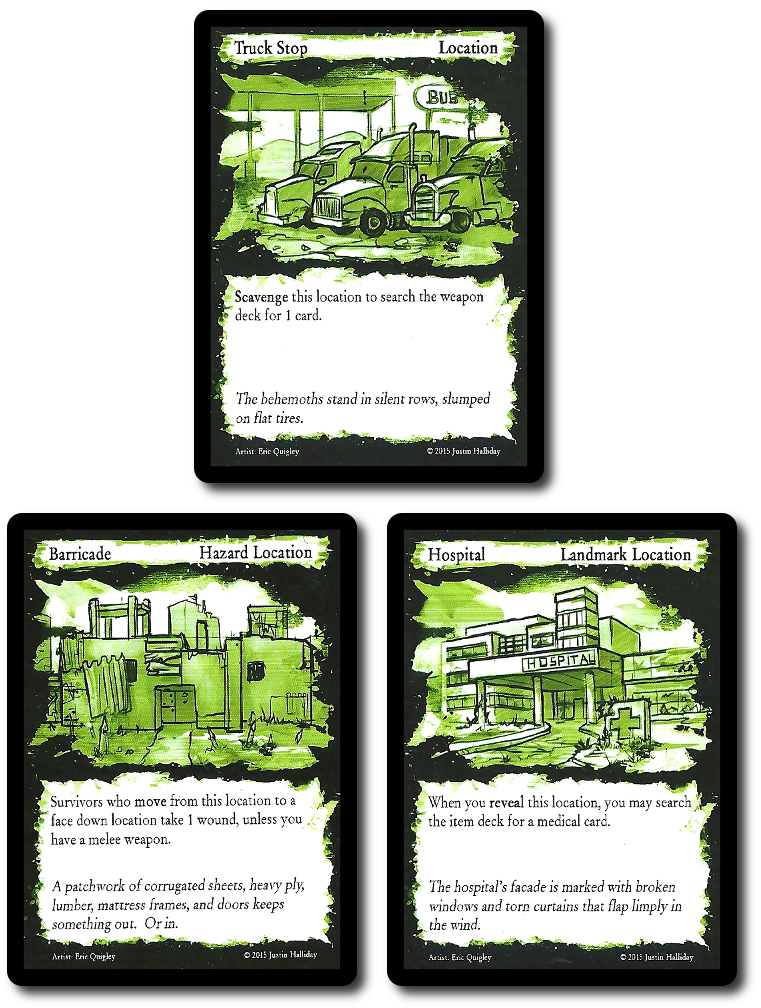
All Location cards will house a mystery encounter, be it the undead or tools to destroy the undead. Most Location cards will also allow the players to draw more cards whenever they are visited or only once when the Location card is revealed.
Weapons
Weapon cards represent melee and ranged weapons that the Survivors can pick up and use to defend themselves. Ranged weapons are useless without “Ammo” Weapon cards. The ammo must match the ranged weapon. For example, bolts for crossbow. When the player has these two items, they can use their weapon and ammo to give themselves a bonus in combat. Melee weapons do not require any ammo to use, but they tend to break. Long story short, weapons are great, but players cannot depend on them. In almost all cases, it’s best to avoid danger whenever possible.
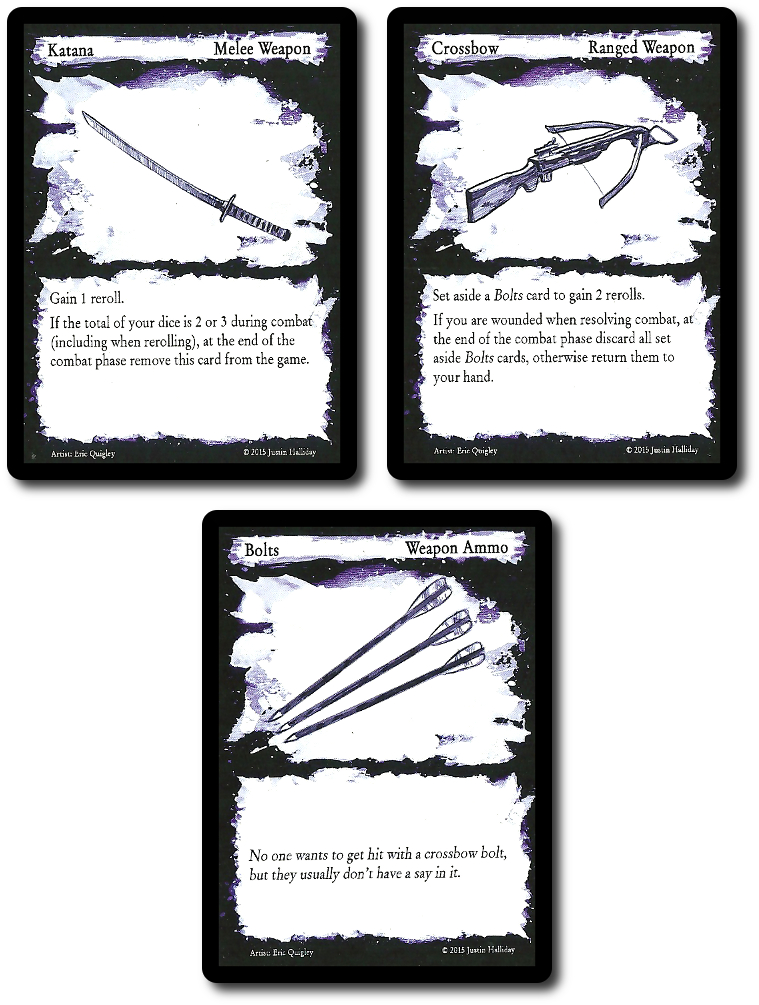
Items
Items range from helpful gear to assist in the process of carrying and finding more items, to medical supplies and food. Items will not help a Survivor in battle, but they can be useful in making decisions regarding where they need to go and what they should avoid. In addition, there are also Item cards that provide protection that is necessary in order to visit “Hazard” Location cards.
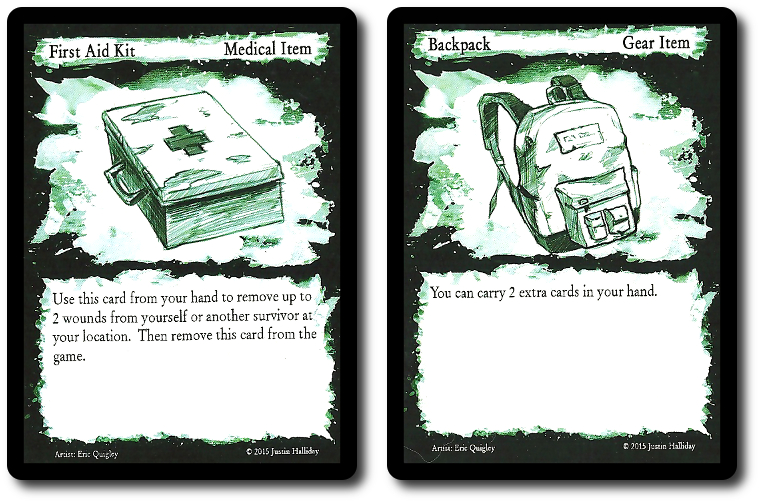
The Quick and the Undead
The Road to Ruin is played in turns with no set number of turns per game. This is a cooperative game, wherein all the players are working together to survive for as long as possible. Table talk is encouraged and necessary to win. This is not an easy game and it will take everyone working together to beat it. A single game turn is summarized here.
Phase 1: Take Action
The player can take 1 of the following actions on their turn.
Move
By default, a player can move their Survivor token from its current location to any other adjacent card. Diagonal movement is only possible if the player’s Survivor is capable of it. If moving from a Location that causes damage, and the player does not have the proper cards to avoid it, they take 1 wound as soon as they move their Survivor token. Some cards also allow the player’s Survivor to travel to distant Location cards that are not adjacent. This still counts as a single move.
If moving to a face-up Location card, read the effects and immediately resolve them if possible. For example, drawing cards.
If moving to a face-down Location cards, flip it over along with any other cards that are also face-down. A player might find weapons and items or a hoard of undead. Some cards might also trigger an Event that forces the player to draw more Threat cards. Weapons and items may be picked up immediately, but the player is still subject to the maximum carry limit. If necessary, players can discard cards to the Location card to indicate they have dropped them. Other players can pick these up later in the game. A player is also welcome to change their equipped gear and weapons at this time to respond to different forms of threats.
Scavenge
Most Locations allow the player to dig around, poke through rooms, and rummage about whatever is left in the locations in hopes of finding something useful. Only Location cards that the player did not move their Survivor to on their current turn can use this action. Depending on the location, scavenging will allow the player to draw 1 or more cards, take cards from the discard pile, or look for a specific card.
Wait
Just as it sounds, the player makes no effort to move their Survivor or scavenge the location. This might sound like a “non-action”, but it’s sometimes the only thing you can do when the Location does not allow scavenging and another Survivor is on the way to help you out of a mess.
Phase 2: Fight the Zombies
If the undead are at the Survivor’s location, combat ensues. Unless the player has to deal with a penalty or a bonus, all combat is resolved by rolling 2 six-sided dice and comparing the total value to the Threat card number value. The bigger the zombie mob, the bigger the threat.

If the number value is equal to or higher than the Threat card value, the player has won the battle. If not, the player takes 1 Wound card and places it next to their Survivor card. Wound cards are double-sided, with 1 side equaling a 1 wound and the other 2 wounds.
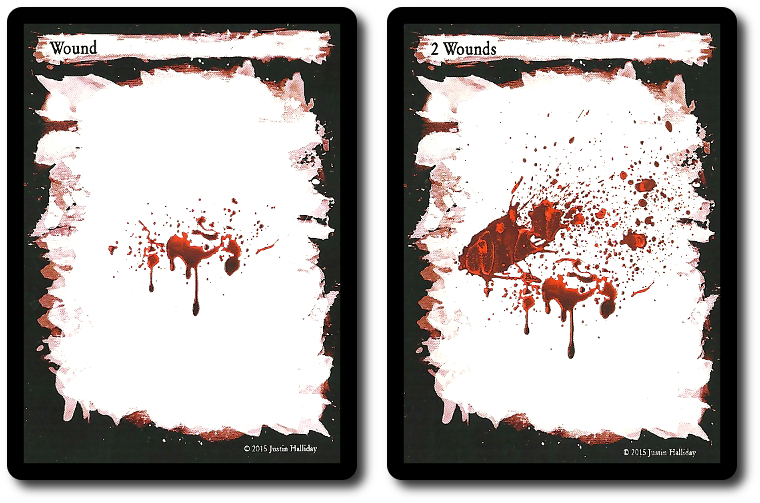
Modifier are applied after the die roll, giving players an opportunity to add points to the total or rerolling some die. Players can also discard from their hand to receive 1 reroll per card they discard.
Win or lose, the Threat card remains at the Location card. The players have just enough strength to get through and avoid the large number of undead. Not remove them. This means a Location that has a Threat card will always remain a threat unless another card or event removes them from play.
If a player’s Survivor dies (takes 3 or more wounds), they are out of the game. All cards equipped and any cards in their hand can be given to any other player who also has a Survivor at the same location. Any not taken (or unable to be given) are discarded. The one exception are cards required to beat the scenario. These are placed on the Location card and can be picked up by other players. Wounds can be healed via use of medial supplies.
Phase 3: End of Turn
The player’s turn is now over. If the player has more than 4 cards in their hand, they must discard down to 4 cards now.
The next player in turn order sequence now takes their turn.
Handing Off Weapons, Items, and Gear
The players will often find more than they need and little of what they want. This is why trading cards with other players is so important. During the player’s Action and End of Turn phase, the player can trade as many times as they like with another player who has a Survivor on the same Location card. Some Locations even allow the player to store their cards for later use.
As this is a game about working and surviving together, it’s a good idea to keep each other healthy by trading medical supplies. The only restriction is that a player cannot initiate a trade when it isn’t their turn.
Winning or Losing the Scenario
The victory conditions will vary depending on the scenario being played. The scenario described in the game set up requires the players to find all 6 “Supply” Item cards and return them to the “Safe House” Location. Other scenarios will require the players to find certain pieces of equipment and deposit them at specific locations other than the Safe House. Almost all scenarios have an easier victory condition if the players are feeling too challenged. Regardless, if the players are able to complete the scenario objective, they have won and survived another day.
The only way to lose the game is to either have all the Survivors perish or walking away from the gaming table in frustration (which I’ve seen).
To learn more about The Road to Ruin, visit he game web page.
Final Word
The Child Geeks had difficulty with this game. Even working as a team, they couldn’t work out how to beat the game most of the time. According to one Child Geek, “Everywhere you go, there are zombies.” And zombies hurt. They hurt bad.” The Child Geeks’ Survivors quickly ran out of ammo and medical supplies, resulting in the zombies ultimately winning. This dismal end, however, did not ruin every Child Geek’s day. As one Child Geek put it, “Yeah, the game is hard, but it is fun. It feels great when you find something you need and can help the team!” When all the games were over – which mostly ended badly – the Child Geeks had a split vote. About half didn’t care for the game and the other half did, resulting in a mixed approval.
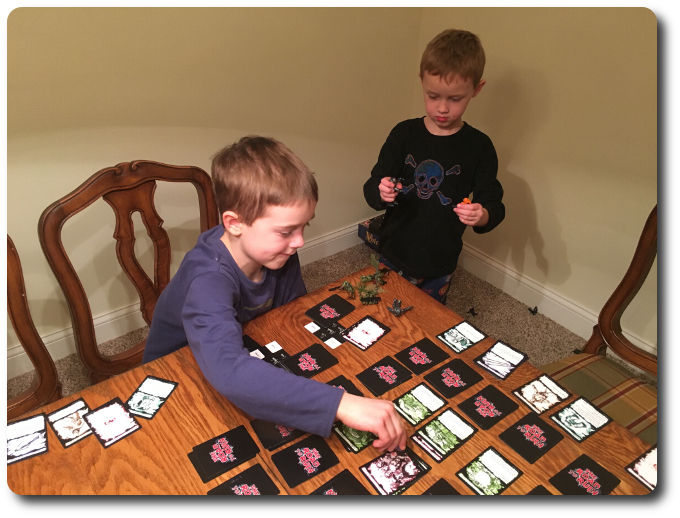
A Child Geek reviews a threat while is little brother stands by to provide Spartan Halo support
The Parent Geeks were similar. Those who enjoyed a really challenging cooperative game with a touch of the undead praised The Road to Ruin. According to one such Parent Geek, “This is exactly how I would expect the Zombie Apocalypse to be. Tough, gritty, and deadly. Living is the trough part, not the dying.” Of course, the other side of the argument from the Parent Geeks makes a lot of sense, too. According to one of these Parent Geeks, “A game that is designed to be too difficult to win isn’t much fun. The game should feel like a challenge, not an impossible task.” Just like the Child Geeks, the votes were split resulting in a mixed level of approval for The Road to Ruin.
The Gamer Geeks were much more pragmatic. They recognized that the game was based on teamwork, communication, and risk taking. They also found the game to be full of luck, chance, and randomness. All of which could be explained, according to one Gamer Geek. “The random encounters and luck with the dice make perfect sense. The Survivors don’t know what is at the location until they arrive. After the card is revealed, everyone knows there are zombies, but each battle with a zombie group is risky.” Which sounded perfectly fine from a thematic point of view, but a number of Gamer Geeks found this game design approach to be a bit damaging. According to one of these Gamer Geeks, “I like games that put realism into their game play, but there is such a thing as too much. Players need to know they have a chance to win and can improve their odds of doing so. This game doesn’t feel like it gives players enough of a chance.” When all the votes were in, just like their peers, the Gamer Geeks gave The Road to Ruin a mixed level of approval.
This is not a game that lets you win easily, but it’s a game you can certainly beat. Unfortunately, victory is determined by luck and chance, not skill. One can improve their odds by having the right equipment and avoiding dangerous places, but that prolongs the inevitable. In this game, death is walking about hunting the Survivors and the players have no choice but to put their Survivors in harm’s way. There is no easy way to win the game. The only way is to plow through danger and hope you come out the other side still breathing.
This game is aptly titled. Each time a player moves from one location to another, there is danger. And this is why I both liked and disliked the game, like so many of our other players. The game never lets up. You are continually being dogged by the undead, pushed to make bigger risks, and asked to sacrifice for an objective that already seems unlikely to achieve. But that’s the game and it does its job well. Never before have I ever played a survival game and been so relieved when my Survivor expired. Not because I’m out of the game but because the stress was starting to get to me.
There is a fine line that all Horror game and Zombie game designers must carefully walk. In order to capture the danger and suspense inherent to the game, they must put the players in tight situations. Too tight and the game goes from “horror” to “horrific”. Too little and the game goes from “horror” to “humor”. In my opinion, The Road to Ruin drops kicks the players into the horrific from the very start and it only gets worse from there.
And that’s why I like it. I have many Zombie games where things begin to snowball if the players don’t practice the most basic risk management and even a few that start the player off with no escape. Take If I’m Going Down…, for example. The Road to Ruin starts the players in the middle. The world has gone to pot, but they have a plan to survive. The plan is risky and the odds of success are slim, but that’s all they got. Players are asked to help lead their Survivors into the storm and come out again. Not unscathed, mind you, as there will be casualties. But even if all but one Survivor perishes, they all win. And players will have to sacrifice their Survivors. This is a game that can end on triumphant note, but almost always with a sad ending.
Surprising difficult, unrelenting, and most certain unapologetic, The Road to Ruin is a game of survival, grit, and guts. If you enjoy a challenge, where everyone starts the game, but few will finish it, and victory is only possible if everyone plays for the group, then do try The Road to Ruin. A trip down this road is sure to teach you something.
This game was given to Father Geek as a review copy. Father Geek was not paid, bribed, wined, dined, or threatened in vain hopes of influencing this review. Such is the statuesque and legendary integrity of Father Geek.



